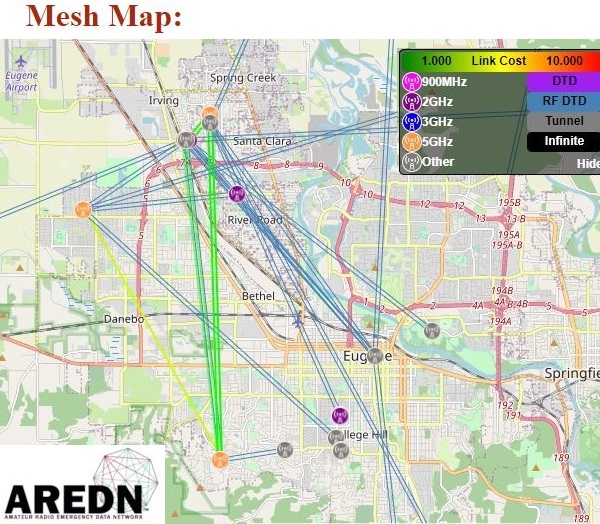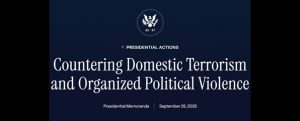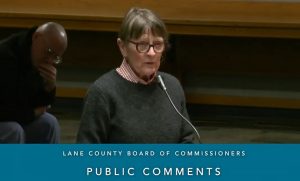Volunteer hams expand emergency data network
6 min read
At the Lane Preparedness Coalition Feb. 15, a presentation about Amateur Radio Emergency Data Network (AREDN), which has been called “a ham radio version of internet.”
[00:00:11] John Simpson (AREDN): I like to say it’s like an alternate reality to the internet.
[00:00:16] The AREDN system is a system of routers linked by microwave, RF, and other means like the internet and other fiber optic resources. It’s a high-speed 130 megabit-per-second TCP/IP data network separate from the internet.
[00:00:34] The system is a self-routing mesh network using OLSR (optimized link state routing) routing technology to pick optimum interconnection paths. And it’s mesh networking, so if an optimum path were to crash, the system can route around it to reestablish communications. There might be a brief outage during the reconnection, but it will come right back up automatically.
[00:00:59] The system supports a wide variety of applications, telephone, chat, shared documents. I’m sure you’ve all used Google Docs, you know, where your cursor’s up here and your friend’s cursor is down here. We have the same exact mechanism. We support web servers, Winlink gateways, and mapping applications.
[00:01:19] Mind you there, this system exists nationwide. We just happen to be a subnet, and we’re not interconnected with California, Washington, or other areas except for specific instances.
[00:01:32] Nodes are interconnected, both with radios using RF, commercially available off-the-shelf equipment. A Mikrotik router, $50. If you have 50 bucks and internet access and a call sign, you can get on and experience the system. It is not a heavy lift.
[00:01:52] One node pretty much fully outfitted would be $500, which would include I would say an IP telephone, and a laptop or a desktop computer so you could gain access through a browser to most of the services. The vast majority of services are either browser-based or using a telephone.
[00:02:15] The tools are useful for ham operators for day-to-day purposes, but also for emergency communication.
[00:02:23] And the people or the nodes that are on this network are a mix of service providers and service consumers. Some people do both.
[00:02:33] There’s a growing interest in this network. There are 270 nodes in Oregon right now with 650 individual devices hanging off of those nodes, over 1,100 microwave link miles in Oregon only. There are 40 nodes in Lane County. I estimate around 10% to 20% of these nodes are in public agency settings, and the balance are in ham stations and repeater sites.
[00:03:01] There is a growing trend to link repeaters over the system. At this time, I believe there are four repeaters in the state of Oregon who link their audio up to permit standard voice communication across a wider area than can be served by a single repeater.
[00:03:20] There is already expressed agency interest in Lane County, Eugene, Springfield, Florence, U of O, and area hospitals, and one of the biggest advantages: It can provide connectivity if the internet goes down.
[00:03:35] One thing to note is it’s designed and maintained by skilled amateur radio operators, and the whole involvement helps maintain ham radio relevancy and modernization and innovation, but also attracts you into the hobby. So here we have a very pro-social environment for technical people to get involved and support this network.
[00:04:04] The overarching goal is to link a variety of agencies across the state, hospitals, EOCs (Emergency Operations Centers), fire dispatch, utilities, transit, etc.
[00:04:15] The system is interlinked with internet-based VPN (virtual private network) tunnels. Your $50 router would plug into your internet and you would negotiate with someone else in the community who would provide you with a hosted tunnel, and then you could also host other clients as how the network spread.
[00:04:40] You can then plug into this port on the end with radio and expand the system and eventually wean yourself from the internet connection. So the nice thing about this is you can take a splash really easily, use the internet, and then when you’re ready with your engineering and your funding and your resources, you can switch over to radio. It is a lot less expensive than satellite communication.
[00:05:10] Another piece of this is the IT systems in your agencies can access the AREDN subnet with appropriate air gapping. So that means if this building, say, were to adopt AREDN and get on the telephone system, any telephone in this entire facility with an access code could make a call over the AREDN mesh network. that’s obviously subject to your air gapping policies and whatnot, but it could be done.
[00:05:42] The LCOG-Willamette internet exchange agreement really boosts the reliability of the AREDN mesh network and it places our community smack dab on the map as a leader in this technology. In fact, we’re for a while going to be the envy of the whole state, I think in terms of that reliability and uptime capability.
[00:06:06] The focus is emergency communication. It seeks to provide amateur radio operators a means to implement this technology in practical ways to support local and regional emergency communication needs. To that end, the project’s objectives are to enable hams to stand up a working mesh node with minimal expertise and effort to configure the mesh network automatically, so that advanced network knowledge is not needed to use low-cost commercially off-the-shelf equipment.
[00:06:38] And to define standards for internetwork integration, we organizationally, I would say the org center for the network comes predominantly out of Salem. We are a ragtag team of volunteers. We’re not, obviously not, we’re not paid because amateur radio operators can’t be paid for this type of stuff.
[00:07:04] And what we are trying to do (when I say we, a specific core group of folks in Salem and myself and some other key operators), we’re creating a calling tree system. When there are problems in the network, we want every node operator to be responsible for the two or three stations that surround that node. So when we notice an issue or a problem, one person doesn’t have to call 500 node operators.
[00:07:34] So this is really just a standard off the shelf Wi-Fi system. With AREDN, we come in and we reflash the firmware on these devices. And so it takes on a secondary role, it opens up the non Wi-Fi portions of the bands that are reserved for amateur radio use. It’s still Wi-Fi in that sense. It does the same thing except it’s using frequencies that aren’t available to the general public.
[00:08:03] And because of that, it opens up significant performance benefits to us. We can change the firmware over Wi-Fi so we don’t have to actually, except for the initial configuration. Once it’s configured, these things can be updated remotely, which really benefits maintaining all of the versions to the latest version.
[00:08:25] We inked the agreement with LCOG, so the next thing will be to install that equipment down there. We are working on establishing a fiber optic transit link between downtown Eugene and Florence. We’re also hoping to get an RF link up and over the coast range out to Florence. And I am currently discussing possible AREDN installations at McKenzie-Willamette Medical Center and PeaceHealth.
[00:08:52] On the horizon we hope to install high visibility targets and backbone sites at Blanton Prairie, Buck (Mountain) and Springfield, and the downtown LCOG hub, if you will. We will be having rooftop-mounted antennas there that have direct line-of-sight to many of these locations.
[00:09:13] The system, as I said, is growing by leaps and bounds, so please see me if your agency is interested in joining this network.
[00:09:21] John Q: Connect with John Simpson to learn more about the AREDN mesh network.




